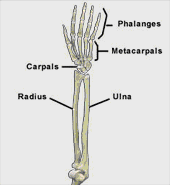
Biomechanics is the term used to describe movement of the body. This section is a review of wrist and hand biomechanics. In order to better understand the biomechanics of the wrist and hand it is important to understand their anatomy. Please read the sections on wrist anatomy and hand anatomy before reading this section. It discusses the bones, ligaments, muscles and other structures that make up the wrist and hand.
The wrist joint is actually made up of many different joints. The end of the radius, the end of the ulna, and the eight carpal bones form these joints. The distal radioulnar joint, the radiocarpal joint, the ulnocarpal joint, the midcarpal joints and the intercarpal joints are the main joints that make up the wrist.
The distal radioulnar joint is the joint that is between the distal end of the radius and the distal end of the ulna. It allows the wrist movements of pronation and supination to occur. Supination is rotation of the forearm so that the palm is turned up. Pronation is rotation of the forearm so that the palm is turned down.
Functionally the radiocarpal, ulnocarpal, midcarpal and intercarpal joints work together to allow the wrist to bend (flex), straighten (extend), move inwards (ulnar deviation), and move outwards (radial deviation).
What are the normal ranges of motion for the wrist?
The normal end ranges of motion for the wrist vary between individuals and between children and adults. The following are approximate end ranges of motion for the adult wrist:
Flexion – 80 degrees
Extension – 80 degrees
Ulnar deviation – 30 degrees
Radial deviation – 20 degrees
Pronation – 80 degrees
Supination – 80 degrees
There are 19 bones in the hand. There are 5 metacarpal bones and 14 phalangeal bones. The metacarpal bones are located in the palm. There is one for each of the fingers and one for the thumb. The phalangeal bones are small, slender bones located in the fingers and in the thumb. There are 3 phalangeal bones in each finger and 2 in the thumb.
The fingers and thumb are often referred to collectively as the “digits”. There are 14 small joints in the hand that allow for movement of the digits. The metacarpophalangeal (MCP) joints are the joints that allow for movement between the palm and each of the digits. The interphalangeal (IP) joints are the smaller joints between the phalangeal bones of each digit. The thumb has one IP joint and each finger has two, called the proximal and distal IP joints. The carpometacarpal (CMC) joints are between the top row of carpal bones and each of the fingers and the thumb. The thumb CMC joint is the most mobile of the CMC joints.
The normal end ranges of motion for the joints of the hand vary between individuals and between children and adults. The following are approximate end ranges of motion for the primary movements of these joints.
What are the normal ranges of motion for the thumb?
Thumb:
CMC flexion – 15 degrees
CMC extension – 20 degrees
CMC abduction* – 70 degrees
MCP flexion – 50 degrees
IP flexion – 80 degrees
* Movement of the thumb away from the plane of the palm.
What are the normal ranges of motion for the fingers?
Fingers:
MCP flexion – 90 degrees
MCP extension – 45 degrees
Proximal IP flexion – 100 degrees
Distal IP flexion – 90 degrees
Muscles control movements of the hand and wrist. The muscles that pronate and supinate the wrist are located deep in the forearm. The biceps muscle of the upper arm also supinates the forearm and wrist. The long muscles that flex the wrist and fingers originate from the inner aspect of the elbow (medial epicondyle). The long muscles that extend the wrist and fingers originate from the outer aspect of the elbow (lateral epicondyle). In addition to these long muscles, there are short muscles located in the hand that move the fingers and thumb.
Visit Joint Pain Info for information on other joint injuries and problems.
